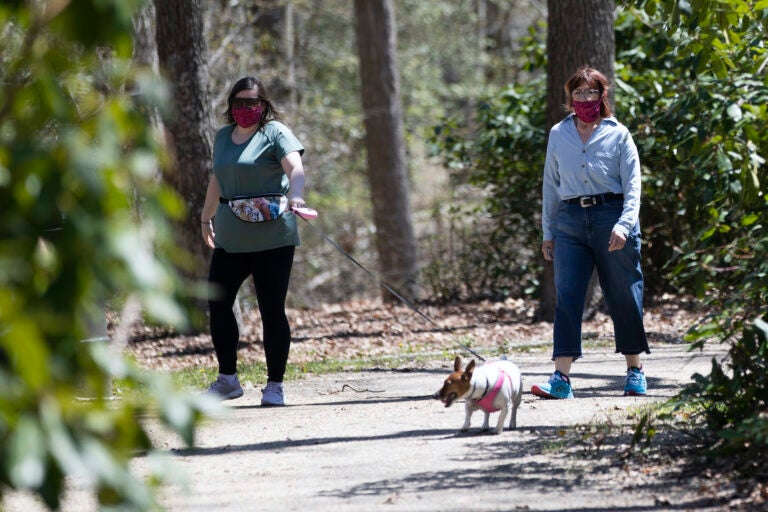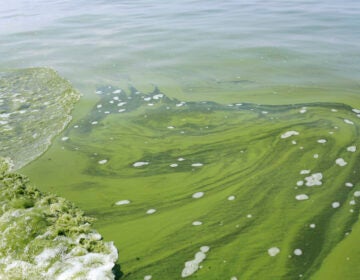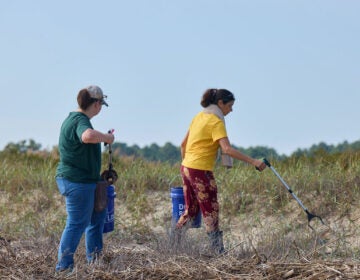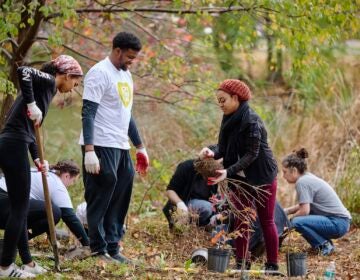Visits to state parks are up. Who’s keeping an eye on water and pandemic safety?
June saw higher numbers. Holiday weekends and sweltering temperatures could push an increase in visitors for July, too.

People wearing a protective face coverings hike at Shark River Park in Wall Township, N.J., Saturday, May 2, 2020. (AP Photo/Matt Rourke)
Are you on the front lines of the coronavirus? Help us report on the pandemic.
Thousands more people are using Pennsylvania’s state parks this year than visited last year.
As summer heat peaks and other areas and activities remain off-limits because of the coronavirus pandemic, park usage has gone up, state officials say. Social distancing and water safety remain important concerns for both park rangers and would-be visitors.
“Our parks have been very crowded the past four weeks,” said Terrence Brady, press secretary for the Pennsylvania Department of Conservation and Natural Resources.
In June, park use — usually measured by vehicle counters, parking lot capacities, and park officials’ estimates — was 6.6 million visits compared to 5.6 million last year. Of Pennsylvania’s state parks, which number over a hundred, six experienced a more than 100% increase in visitors. An additional 24 parks saw their numbers increase by more than 50%.
A combination of the holiday weekend and sweltering temperatures could push an increase in visitors for July, too.
New Jersey and Delaware seem to be experiencing the same bounce. Community mobility reports compiled through data from Google indicate increased activity at all regional parks and outdoor recreation areas, with the most recent numbers, as of July 19, showing Pennsylvania at 151%, Delaware at 131% and New Jersey at 178% of average visitation. Those reports, however, use a baseline comparison of rates in January and February 2020 and aren’t exactly indicative of average summer visitation rates, which are typically higher because of warm weather and more people taking vacation time.
In Delaware, where state park entry fees were waived March 1 through April 30, visitor numbers seem to have increased even though most programs run by the state Department of Natural Resources and Environmental Control are canceled because of the coronavirus. Park employees reported so many full beaches — and residents violating social distancing guidelines — that the state recently imposed a new 60% capacity limits on visitor vehicles at those beach parks.
“Many of our parks saw increased visitation during the fee waiver in the spring,” said DNREC spokesperson Michael Globetti, adding that it’s “challenging to compare visitation versus a year ago due to the state park fee waiver… coupled with increased capacity limitations for day use at our beach parks since that time.” A final tabulation for park usage and visitor numbers is not yet available, Globetti said.
In New Jersey, state and county parks were closed by an executive order from Gov. Phil Murphy in early April and stayed closed for almost a month. The Saturday they reopened in May, eight parks were “overrun.” Since then, state park officials have been careful to monitor parking vehicle limits at 50% capacity, and Department of Environmental Protection spokesperson Larry Hajna said would-be park visitors should check park status and the state’s Facebook updates before heading out.
Hajna could not speak to any increases or decreases in park attendance compared to other summers.
With the increase in visitors, who’s keeping an eye on social distancing at the parks?
The wave of new attendees has stretched staffing in several Pennsylvania park locations, the Department of Conservation and Natural Resources’ Brady said.
Park officials, he added, “are not social-distancing, mask-wearing police, meaning they try to educate and encourage rather than enforce on both.”
Globetti reported that Delaware’s park system has employed less seasonal staff than in other summers because of various program closures, as well as the limited opening of Killens Pond Water Park — which closed abruptly last week after an employee tested positive for COVID-19.
Limits on parking, which differ by state, are an attempt to curb any excess of visitors and maintain conditions in which social distancing is possible.
Walk, don’t run — and watch where you swim
According to the Centers for Disease Control and Prevention, evidence does not suggest that the coronavirus can spread through the water in pools, hot tubs, or water playgrounds. That doesn’t mean all states or cities are opening their swimming areas, however. In Philadelphia, for example, city pools are staying closed for the remainder of the year.
Across Pennsylvania, the closure of indoor pools and swim clubs means some are flocking to outdoor swim areas. But state park swimming beaches and pools are limited to 75% of their normal capacity, monitored by parking lot use and overseen by park rangers and other officials.
In New Jersey, both indoor and outdoor swimming areas have been granted permission to reopen, with indoor pools limited to 25% and outdoor pools limited to 50%.
In Delaware, indoor and outdoor pools are permitted to operate at a slightly more generous 60% capacity.
Eight out of New Jersey’s 14 state park water areas are open as part of a swimming schedule phase-in program, according to the state website. Swimming is permitted only when lifeguards are on duty.
Most swimming beaches in Pennsylvania, on the other hand, are not actively guarded. So swimming is open during all hours at approved beaches, but visitors’ attention to both COVID-19 safety and water safety is key.
Recent increased use is unlikely to affect water quality or disturb the environment in any appreciable way. But the Army Corps of Engineers has reported a rise in adult drownings, and open-water swimming can be dangerous in ways that are not immediately obvious.
“With some public beaches and community pools closed due to the COVID-19 pandemic, we are finding more people this summer are swimming, wading, floating, and playing in open water areas (lakes, rivers, ponds, etc.) not designated for swimming,” Pam Doty, the Army Corps of Engineers’ national water safety program manager, said in a press release earlier this month. “Unfortunately, these areas are associated with hidden dangers that swimmers may not be aware of, including waves, currents, drop-offs, underwater obstructions and others.”
“July is the month when we normally see the most water-related accidents and fatalities, so there is even more reason to be concerned this year,” Doty added.
Water safety is always a top priority, said Brady, of Pennsylvania’s Department of Conservation and Natural Resources.
“That’s why swimming in state park lakes is permitted only at approved, designated and signed swimming beaches … these lakes are large, and rangers and park officials can’t watch all of them,” Brady said. “Unlike our lake swim beaches, all of our pools are staffed by certified lifeguards, but we direct visitors to always keep an eye on those under their charge.”

Get daily updates from WHYY News!
WHYY is your source for fact-based, in-depth journalism and information. As a nonprofit organization, we rely on financial support from readers like you. Please give today.



![CoronavirusPandemic_1024x512[1]](https://whyy.org/wp-content/uploads/2020/03/CoronavirusPandemic_1024x5121-300x150.jpg)



